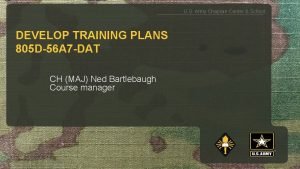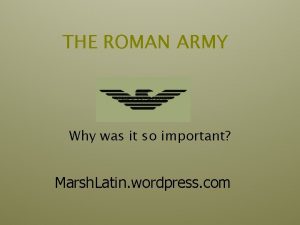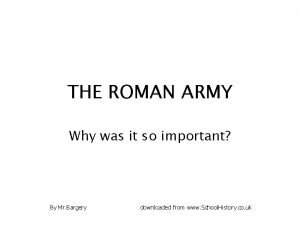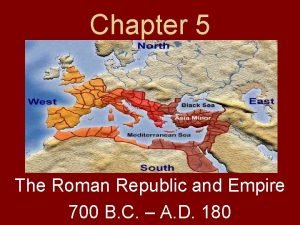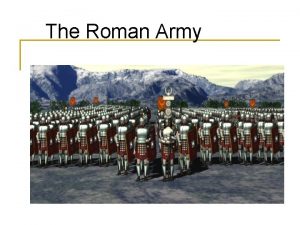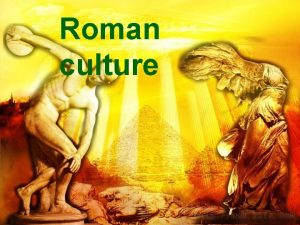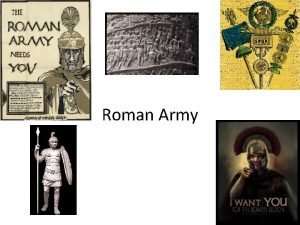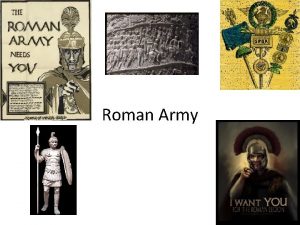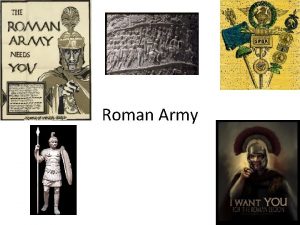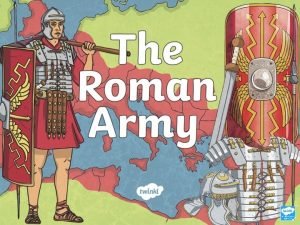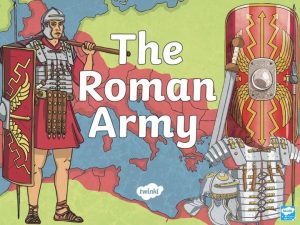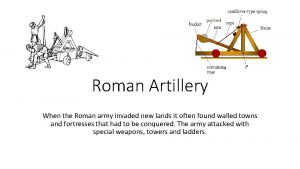The Roman Army In the following presentation and





































- Slides: 37

The Roman Army

In the following presentation and videos you will be shown examples of: • Leadership – Someone has to command (call the shots) • Organization – The larger the fighting force the more organization is needed • Tactics/strategy - the art of disposing armed forces in order of battle and of organizing operations, especially during contact with an enemy. • Logistics – Supplying a fighting force with what it needs to get the job done. • Intelligence - Knowing what the enemy is doing or plans to do • Technology – The weapons and machines that make victory easier

The Roman army was the largest and toughest fighting force in the ancient world. One of the main reasons Rome became so powerful was because of the strength of its army. It conquered a vast empire that stretched from Britain all the way to the Middle East.

The army was very advanced for its time. The soldiers were the best trained, they had the best weapons and the best armor. Being a soldier was a serious business. When the Romans invaded Britain, their army was so good that it took on armies 10 times its size and won!

There were two main types of Roman soldiers: legionaries and auxiliaries. legionaries auxiliaries.

The legionaries were the elite (very best) soldiers. A legionary had to be over 17 years old and a Roman citizen. Every new recruit had to be fighting fit - anyone who was weak or too short was rejected.

Legionaries signed up for at least 25 years' service. But if they survived their time, they were rewarded with a gift of land they could farm. Old soldiers often retired together in military towns, called ‘colonia’.

An auxiliary was a soldier who was not a Roman citizen. He was only paid a third of a legionary’s wage. Auxiliaries guarded forts and frontiers but also fought in battles, often in the front lines where it was the most dangerous.

Most auxiliary soldiers in the Roman Empire came from countries outside Italy. There were soldiers from Africa, France, Germany, Spain and the Middle East.









At its largest, there might have been around half a million soldiers in the Roman army! To keep such a large number of men in order, it was divided up into groups called ‘legions’. Each legion had

A legion was further divided into groups of 80 men called ‘centuries’. The man in charge of a century was known as a ‘centurion’. He carried a short rod, to show his importance. He would also use it to beat any soldier who disobeyed him.

Video: ROMAN ARMY STRUCTURE

Some soldiers had special skills. They shot bows and arrows, flung stones from slingshots, or could swim rivers to surprise an enemy.

VIDEO : MILITARY TECHNOLOGY

Roman soldiers usually lined up for battle in a tight formation. After a terrifying burst of arrows and artillery, the Roman soldiers marched at a slow steady pace towards the enemy. At the last minute, they hurled their javelins and drew their swords, before charging into the enemy. Then they used cavalry (soldiers riding horses) to chase anyone who tried to run away.

A Roman soldier was a well-trained fighting machine. He could march 20 miles a day, wearing all his armor and equipment. He could swim or cross rivers in boats, build bridges and smash his way into forts.

After a long day’s march, Roman soldiers had to build a camp, complete with a ditch and a wall of wooden stakes. The next day, they had to do it all again! A Roman soldier almost always followed orders. Anyone who didn't faced tough punishments. If you fell asleep on duty, you could be sentenced to death.

Roman soldiers weren't always at war - they spent most of their time training for battle. They practiced fighting in formation and man-to -man. Legionaries also patrolled their conquered territories and built roads, forts and aqueducts (a bridge which carried water).











 Combined arms registry
Combined arms registry Cursus honorum
Cursus honorum Led first roman army to britain
Led first roman army to britain Roman army structure
Roman army structure Join the roman army
Join the roman army Roman soldier recruitment poster
Roman soldier recruitment poster How was the roman army organised
How was the roman army organised How was the roman army organised
How was the roman army organised Roman army recruitment poster
Roman army recruitment poster Roman republic vs roman empire
Roman republic vs roman empire Brow presentation birth
Brow presentation birth Fundal height transverse lie
Fundal height transverse lie Importance of following directions in the army
Importance of following directions in the army Nasa space shuttle
Nasa space shuttle The following presentation
The following presentation The following presentation
The following presentation The following presentation
The following presentation Hình ảnh bộ gõ cơ thể búng tay
Hình ảnh bộ gõ cơ thể búng tay Ng-html
Ng-html Bổ thể
Bổ thể Tỉ lệ cơ thể trẻ em
Tỉ lệ cơ thể trẻ em Chó sói
Chó sói Chụp tư thế worms-breton
Chụp tư thế worms-breton Alleluia hat len nguoi oi
Alleluia hat len nguoi oi Các môn thể thao bắt đầu bằng tiếng nhảy
Các môn thể thao bắt đầu bằng tiếng nhảy Thế nào là hệ số cao nhất
Thế nào là hệ số cao nhất Các châu lục và đại dương trên thế giới
Các châu lục và đại dương trên thế giới Công thức tiính động năng
Công thức tiính động năng Trời xanh đây là của chúng ta thể thơ
Trời xanh đây là của chúng ta thể thơ Mật thư tọa độ 5x5
Mật thư tọa độ 5x5 Phép trừ bù
Phép trừ bù Phản ứng thế ankan
Phản ứng thế ankan Các châu lục và đại dương trên thế giới
Các châu lục và đại dương trên thế giới Thơ thất ngôn tứ tuyệt đường luật
Thơ thất ngôn tứ tuyệt đường luật Quá trình desamine hóa có thể tạo ra
Quá trình desamine hóa có thể tạo ra Một số thể thơ truyền thống
Một số thể thơ truyền thống Cái miệng nó xinh thế
Cái miệng nó xinh thế Vẽ hình chiếu vuông góc của vật thể sau
Vẽ hình chiếu vuông góc của vật thể sau
